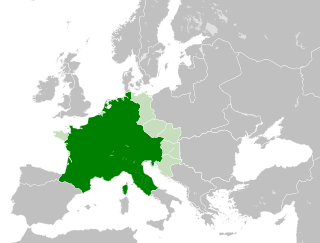Related Research Articles

Geneva is the second-most populous city in Switzerland and the most populous city of Romandy, the French-speaking part of Switzerland. Situated in the south west of the country, where the Rhône exits Lake Geneva, it is the capital of the Republic and Canton of Geneva.

Rouen is a city on the River Seine in northern France. It is the prefecture of the region of Normandy and the department of Seine-Maritime. Formerly one of the largest and most prosperous cities of medieval Europe, the population of the metropolitan area is 702,945 (2018). People from Rouen are known as Rouennais.

The Carolingian Empire (800–888) was a large Frankish-dominated empire in western and central Europe during the Early Middle Ages. It was ruled by the Carolingian dynasty, which had ruled as kings of the Franks since 751 and as kings of the Lombards in Italy from 774. In 800, the Frankish king Charlemagne was crowned emperor in Rome by Pope Leo III in an effort to transfer the Roman Empire from the Byzantine Empire to western Europe. The Carolingian Empire is considered the first phase in the history of the Holy Roman Empire.

The Encyclopædia Britannica Eleventh Edition (1910–1911) is a 29-volume reference work, an edition of the Encyclopædia Britannica. It was developed during the encyclopaedia's transition from a British to an American publication. Some of its articles were written by the best-known scholars of the time. This edition of the encyclopaedia, containing 40,000 entries, has entered the public domain and is easily available on the Internet. Its use in modern scholarship and as a reliable source has been deemed problematic due to the outdated nature of some of its content. Modern scholars have deemed some articles as cultural artifacts of the 19th and early 20th centuries.

Neustria was the western part of the Kingdom of the Franks.

The Kingdom of France was organised into provinces until the National Constituent Assembly adopted a more uniform division into departments (départements) and districts in late 1789. The provinces continued to exist administratively until 21 September 1791.

Nancy is the prefecture of the northeastern French department of Meurthe-et-Moselle. It was the capital of the Duchy of Lorraine, which was annexed by France under King Louis XV in 1766 and replaced by a province, with Nancy maintained as capital. Following its rise to prominence in the Age of Enlightenment, it was nicknamed the "capital of Eastern France" in the late 19th century. The metropolitan area of Nancy had a population of 511,257 inhabitants at the 2018 census, making it the 16th-largest functional urban area in France and Lorraine's largest. The population of the city of Nancy proper is 104,885.

Pierre Jeannin (1542–1623) was a French statesman, otherwise known as a surintendant des finances. In 1573 he married Anne Gueniot and had one daughter, Charlotte Jeannin.

John Hacket was an English churchman, Bishop of Lichfield and Coventry from 1661 until his death.

The Treaty of Mersen or Meerssen, concluded on 8 August 870, was a treaty to partition the realm of Lothair II, known as Lotharingia, by his uncles Louis the German of East Francia and Charles the Bald of West Francia, the two surviving sons of Emperor Louis I the Pious. The treaty followed an earlier treaty of Prüm which had split Middle Francia between Lothair I's sons after his death in 855.

Duke of Richmond is a title in the Peerage of England that has been created four times in British history. It has been held by members of the royal Tudor and Stuart families.

Hincmar, archbishop of Reims, was a Frankish jurist and theologian, as well as the friend, advisor and propagandist of Charles the Bald. He belonged to a noble family of northern Francia.

Jacques Sirmond was a French scholar and Jesuit.
The Capitulary of Quierzy was a capitulary of the emperor Charles II, comprising a series of measures for safeguarding the administration of his realm during his second Italian expedition, as well as directions for his son Louis the Stammerer, who was entrusted with the government during his father's absence. It has traditionally been seen as the basis on which the major vassals of the kingdom of France such as the counts of Flanders, were enabled to become more independent.

Thomas Simon, English medalist, was born, according to George Vertue, in Yorkshire about 1623.
A capitulary was a series of legislative or administrative acts emanating from the Frankish court of the Merovingian and Carolingian dynasties, especially that of Charlemagne, the first emperor of the Romans in the west since the collapse of the Western Roman Empire in the late 5th century. They were so called because they were formally divided into sections called capitula.
The Cappel family was a French family which produced distinguished jurists and theologians in the 15th and 16th centuries. The family also took the Latin name Tillaeus based on the fief le Tilloy.

Charles II Francis of Austria was an Archduke of Austria and ruler of Inner Austria from 1564. He was a member of the House of Habsburg.

Louis II, known as Louis the Stammerer, was the king of Aquitaine and later the king of West Francia. He was the eldest son of Emperor Charles the Bald and Ermentrude of Orléans. Louis the Stammerer was physically weak and outlived his father by a year and a half.

In the Kingdom of England, the title of Secretary of State came into being near the end of the reign of Queen Elizabeth I (1558–1603), the usual title before that having been King's Clerk, King's Secretary, or Principal Secretary.
References
- ↑ Christian Pfister (1911). "Capitulary" . In Chisholm, Hugh (ed.). Encyclopædia Britannica. 5. (11th ed.). Cambridge University Press. pp. 282-283.